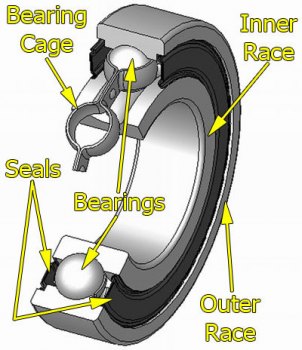Why Can’t You Re-use Bearings?
Posted by Bare | Last Updated August 22, 2013Most typical bearings are comprised of 4 basic parts – the inner race, the outer race, the bearings and the bearing cage. Many bearings now come pre-lubed from the manufacturer with seals to both keep the lube in place and protect the bearing against dirt. The pictured bearing is a standard ball-bearing like most wheels will have. On rare occasions, you may see tapered roller bearings and the like, but for the purpose of this article let’s just consider the ball-bearing pictured.
Most bearings like this are press fit into place on the outer race with limited access to this race once the bearing is installed. Limited access means that when it is time to remove the bearings, the only way to get them out involves “loading” the bearings and bearing cage by pressing on the inner race. Some removal involves beating bearings out with hammers and special tools while some removal can be accomplished with a shop press. In almost all of these situations you are pressing on the inner race to remove a bearing which is held in place by the outer race. This process of “loading” the bearings creates microscopic dents on the bearing races (both inner and outer) and on the balls themselves. While the bearing may feel OK after removal, these microscopic dents will come back to haunt you later.
The technical term for these “dents” is called brinneling.
http://en.wikipedia.org/wiki/Brinelling
Brinelling refers to a material surface failure caused by contact stress that exceeds the material limit. This failure is caused by just one application of a load great enough to exceed the material limit. The result is a permanent dent or “brinell” mark. It is a common cause of roller bearing failures and loss of preload in bolted joints when a hardened washer is not used. Engineers can use the Brinell hardness of materials in their calculations to avoid this mode of failure. A rolling element bearing’s static load rating is defined to avoid this failure type. A similar-looking kind of damage is called false brinelling. This occurs when contacting bodies vibrate against each other in the presence of very small loads. The result is a finely polished surface that resembles a brinell mark but has not permanently deformed either contacting surface.


Great post.
[…] There is no way to remove the bearings without damaging them. […]
Thanks for the info, very helpful discription about the fuction of these bearings.
I’m new to your site and have learned so much in the last few days! Great site it’s like having a uncle in the motorcycle business who is a Master mechanic and can explain thing that a 3 year old can understand. I’m a owner of older VTX 1800 and have repaired or prevented future failures all because of you and or staff. I can’t thank you enough and truly enjoy everything I can read about this great bike. (P.S. I belong to several vtx1800 sites that cover every country around the world and have quoted your posts and have told many many bikers to checkout Bareass chopper tech.)
Thanks again